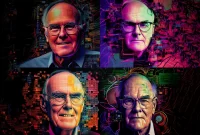IoT, applications and benefits and IoT technology
The Internet of Things (IoT) refers to any physical device that is able to exchange information (without human interaction) with a unique identifier (uids) on a network. Objects on the Internet of Things can be a biopsy in the body of farm animals to detect, an intelligent coffee machine or a sensor in the car to warn the driver if the car tire is defective. The idea of adding sensors to objects was a major topic of discussion in the 1980s and 1990s (although some projects had already begun, but because technology was not yet ready, the projects were progressing slowly). The concept of IoT has grown with the advent of wireless Internet, and since then organizations have increasingly used the IoT in various industries for better performance, better customer understanding and more comprehensive service, easier decision making to increase the value of business. The Internet of Things (IoT) implies that technology can be not only a tool for business development but also a tool for personal consumption.
According to the Gartner Institute, in 2017, about eight billion and four hundred million devices were connected to the Internet. The number has increased by about 30% compared to the previous year, and this number will probably reach 24 billion and four hundred million units by 2020.
The IoT ecosystem consists of devices that use processors, sensors, and communication hardware to collect, send, and analyze data. The IoT shares the data it collects from its environment by connecting to the Internet gateway, and sometimes acts on the information it receives from each other. These devices often perform tasks without human intervention. The Internet of Things has the potential to fundamentally change the way humans interact with their environment. The ability to monitor and manage, optimize the performance of systems and processes, allows decisions based on data and information to enter a new phase. The overall goal of the Internet of Things is to improve the quality of human life.The Internet of Things is used in various fields and industries. Below we examine some of these fields.
the health
Many people now use wearable IoTs to monitor exercise, sleep and other health habits. Other applications of the Internet of Things include patient monitoring devices, electronic records, and other hospital accessories such as sensors that automatically adjust temperature and humidity. Statistics show that by 2020, the IoT’s share of medicine will reach $ 117 billion. .
houses
The following are some uses of the Internet of Things in the home.Energy Management: Thermostats and sensors that monitor behaviors and provide the best temperature for homes.Security and safety: Collecting information using cameras and sensors, analyzing data and alerting the user when needed.Doing housework: Smart appliances can operate independently (without human intervention) to perform tasks such as making coffee, eating food, vacuuming automatically and based on human behavior analysis.An IoT, for example, can automatically order the food it needs when it needs to, by examining daily consumption patterns and setting priorities.
Companies and retailers
The following are some uses of the Internet of Things in corporations and retail.Energy and environmental management: Intelligent heating and cooling devices automatically regulate the temperature and prevent energy loss if the office is empty.Building Security: The camera, an intelligent system, can automatically detect abnormal patterns in video and send data instantly to officials. Such security systems can reduce the cost of human error.
Improve employee performance: Measure and control, extract data, and perform routine tasks improve employee performance.
products
The manufacturing industry has benefited the most from the IoT. Data collection sensors on factory shelves or warehouse shelves can share potential problems with the person in charge. With IoT, manufacturers can have a comprehensive program for optimizing operations, maintenance, inventory control, health and safety, and the production process. Investment in the Internet of Things is projected to reach $ 2 billion by 2020.
vehicles
The Internet of Things will have far-reaching implications for how cars, cars, trains, trucks, and even airplanes are used. The impact of IoT on vehicle performance, design and service is undeniable. For example, installing IoT to monitor and monitor the health of vehicles and alerting in the event of disruption or theft, designing self-driving vehicles, announcing the amount of traffic and providing entertainment to create a good experience for the passenger and. Is possible. According to Gartner, more than 250 million cars will be connected to the Internet by 2020.
Energy
Intelligent meters not only automatically collect data, but also enable predictive modeling for energy efficiency scheduling and energy efficiency by parsing and analyzing energy use.
Cities
The concept of smart cities is becoming a reality with the evolution of the areas we mentioned earlier. Smart city services such as smart hospitals, smart buildings, smart parking networks, smart factories, and so on are taking shape. With the development of sensors, security cameras, city-wide traffic lights, and their interconnection, comprehensive information for analyzing human behavior in the city is obtained, based on which urban planners can build a healthy and dynamic city for citizens (not cars). In addition to using the Internet of Things to improve living standards, we need to know more about the safe use of IoT, which is why we will talk about the Internet of Things and cybersecurity in the next article.
The telecommunications industry has been significantly affected by the Internet of Things as it expands, increasing the need for a reliable connection. Raspina Data Processing Company has taken an effective step towards reaching the smart city by equipping companies and organizations with stable and reliable Internet through its dedicated bandwidth service and providing public Wi-Fi service.
Today, the term “IoT” pervades the world of information and communication technology. Smart energy, smart agriculture, smart animal husbandry, smart home and building, smart transportation, smart health, and the smart city and environment in general are terms that fascinate many politicians, managers, professionals, and businesses around the world with unique features. They have created new technologies. Today, the Internet of Things, with its intelligent solutions, has penetrated into all aspects of human life and promises a productive, pleasant and comfortable future. In the first part of the IoT article series, we want to introduce you to the concept of IoT, its history, functionality, and benefits. So join us.
History of the Internet of Things
The root of the phrase “Internet of Things”
Kevin Ashton, co-founder of the Auto-ID Center at MIT, USA, was the first to use the term “Internet of Things” in a presentation for Procter & Gamble (P&G), a multinational consumer goods company. In the state of Ohio – used in 1999. Ashton called his presentation “the Internet of Things” to alert senior P&G executives to the RFID system. Ashton wanted to use the new technology trend in his message on the eve of the new century. This revolutionary process was nothing but the Internet. On the other hand, MIT professor Neil Gershenfeld, in the same year, published a book entitled “When Objects Begin to Think.” Gersenfeld, however, did not use the exact phrase “Internet of Things” in his book; It provided a clear picture of the future direction of the IoT.
This convergence has helped to bridge the gap between operational technology (OT) and information technology (IT) and has enabled the analysis of unstructured data generated by the machine to achieve the desired insight to improve and improve the status quo.
Ashton was the first to use the term IoT; But the idea of connected devices has been around since the 1970s under the headings of “embedded Internet” and pervasive computing.
The bedrock of the formation of the Internet of Things
The first Internet object or device was a beverage machine at Carnegie Mellon University in the United States in the early 1980s. At the time, programmers could use the web to remotely monitor device status and monitor performance.
The Internet of Things (IoT) evolved from machine-to-machine (M2M) communication, that is, machines that connect to each other through a network without human interaction. M2M refers to connecting a device to the cloud space, managing it, and collecting data.
The IoT has provided a sensor network of billions of smart devices by taking machine-to-machine communication to the next level. This network connects people, systems, and applications to collect and share data. In other words, M2M, as the foundation of this process, provides the communication that guarantees the implementation of the Internet of Things.
The Internet of Things is also a natural extension of SCADA (SCADA); SCADA is a class of process control software applications used to collect real-time data from remote locations to control equipment and conditions. SCADA systems include hardware and software components. The hardware collects the data and transfers it to the computer on which the SCADA software is installed. This data is then processed and provided in a timely manner. It can be said that following the evolution of SCADA, the latest generation of SCADA systems have gradually become the first generation of IoT systems and have provided a platform for the growth and development of these systems.
It should be noted, however, that the concept of the IoT ecosystem did not materialize until mid-2010. It was this year that the Chinese government announced that it would prioritize the IoT in its five-year plan and give the IoT ecosystem an objective and realistic meaning.
How does the Internet of Things work?
The IoT ecosystem is a collection of intelligent web-based devices that use embedded processors, sensors, and communication hardware to collect, send, and process data received from the environment. The data collected by the sensors is sent to the cloud by connecting to an IoT port or Edge Device for analysis, or is analyzed locally. Sometimes, these devices communicate with other connected devices and act on the information they receive from each other.
It should be noted that the connection, network, and communication protocols used with these web-based devices rely heavily on specific IoT applications.
The Internet of Things has many benefits for organizations and businesses. With the help of IoT, organizations can:
Monitor the overall processes of their business;
Improve the customer experience;
Save time and money;
Increase employee productivity;
Integrate and coordinate business models;
Make better business decisions; and finally
Make more money.
Cyber security expert Bruce Schneier praised the Internet of Things at the European Information Security Conference in London:
The Internet now thinks, feels, and acts, and I think that definition is a robot.



